
The Ultimate Guide to Industrial SEO for Online Growth
A strong online presence is crucial for any business to thrive, and search engine optimization (SEO) plays a key role in achieving this.
With the industrial marketplace getting more crowded, SEO becomes even more crucial for gaining visibility and reaching your target audience. A combination of tactics like keyword optimization, strategic backlink building, and quality content creation can help boost your search rankings.
But, with 96.55% of content getting zero traffic from Google, how exactly can you execute an industrial SEO strategy that actually yields results?
This guide reveals actionable strategies on how to do SEO for industrial companies.
But first:
What Is Industrial SEO?
Industrial SEO is a tailored search engine optimization strategy that aims to enhance the online visibility of manufacturing companies on search engines like Google and Bing. It involves applying basic SEO principles to a manufacturing, construction, or industrial service website to generate more organic traffic.
Key components of industrial SEO include targeting technical keywords relevant to your sector, creating quality content, and optimizing your industrial website to achieve high search rankings.
Why SEO Matters for Industrial Companies
The core purpose of a well-rounded SEO strategy is to boost your site’s visibility across search engines and improve your online growth. This is quite important as 73% of site clicks can be attributed to organic search results, according to a report by Brightedge.
The same report also reveals that 90% of enterprise companies plan to emphasize SEO more. Considering this, an industrial company like yours should also consider adding SEO to its marketing strategy. This equips you to dominate search engines and attract prospective customers.
Here’s how:
- Increased visibility: SEO can boost your website’s presence through higher search rankings, making it easier for potential clients to find your business.
- Targeted traffic: A well-implemented SEO strategy will drive relevant traffic (potential customers) to your site by optimizing for industry-specific keywords.
- Builds brand reputation: Through strategic content creation, SEO can also help position your brand as an industry authority or thought leader.
Lastly, an excellent SEO campaign can boost awareness and credibility, especially when techniques like link building come into the picture.
How to Develop an SEO Strategy for Industrial Companies
Follow these seven steps to build a solid SEO strategy for your industrial website.
1. Understand Your Audience and Industry
Understanding your ideal customer is the cornerstone of an effective industrial SEO strategy. Identifying their specific needs allows you to accurately target your SEO efforts, especially when choosing keywords or topics to cover.
Here are a few details you may want to look out for when assessing your target audience:
- Pain points: What are the specific problems they’re dealing with?
- Job functions: Are they decision-makers, managers, or professionals?
- Technical knowledge: How well do they understand the problem or challenges they’re experiencing? Also, do they know about existing solutions and the possible benefits of your product or service?
Also, knowing your industry allows you to create content that deeply resonates with your target audience. You should run a competitor analysis to get a good glimpse into what’s working in your industry. Look at the competitors’ SEO strategies (like the keywords they’re targeting, the type of content they’re producing, how their website architecture is set up, etc.) to identify gaps you can take advantage of.
How can you get these insights about your audience and industry?
- First, you can conduct surveys or interviews with current customers. These surveys should aim to gain insights into their decision-making process, business needs solved by your product, and any other information relevant to your SEO strategy.
- Subscribe to industry publications, attend trade shows, and participate in online forums to stay on top of industry trends and buyer behavior. Tools like Brandwatch or Sprout Social can help you monitor industry conversations and identify emerging topics of interest to your target audience.
- If you have a manufacturing e-commerce platform, you can also check your customer history to see what they’ve been interested in over time.
Overall, aim to gather information to guide your SEO strategy toward prospects more likely to convert into leads.
2. Conduct Comprehensive Keyword Research
Proper keyword research helps you identify the specific terms your target audience is typing into search engines. This way, you can boost your chances of ranking for those terms and getting seen online.
Here are some effective keyword research techniques you can follow:
Brainstorm and Collate Broad Topics
Here, you’re looking for broad or common search terms, topics, and phrases related to your niche. You can do this through a quick brainstorming session with your team.
The idea is to consider specific problems you solve for your target audience and use that to make a list of seed keywords.
The first step is to talk to your sales and customer support teams. These teams are in direct contact with your customers, which means they may know topics or issues customers struggle with that you can create content for.
The second option is to engage the help of AI tools. Here’s an example of a simple keyword brainstorming prompt on ChatGPT. Of course, more details can help you get results that align with your business.
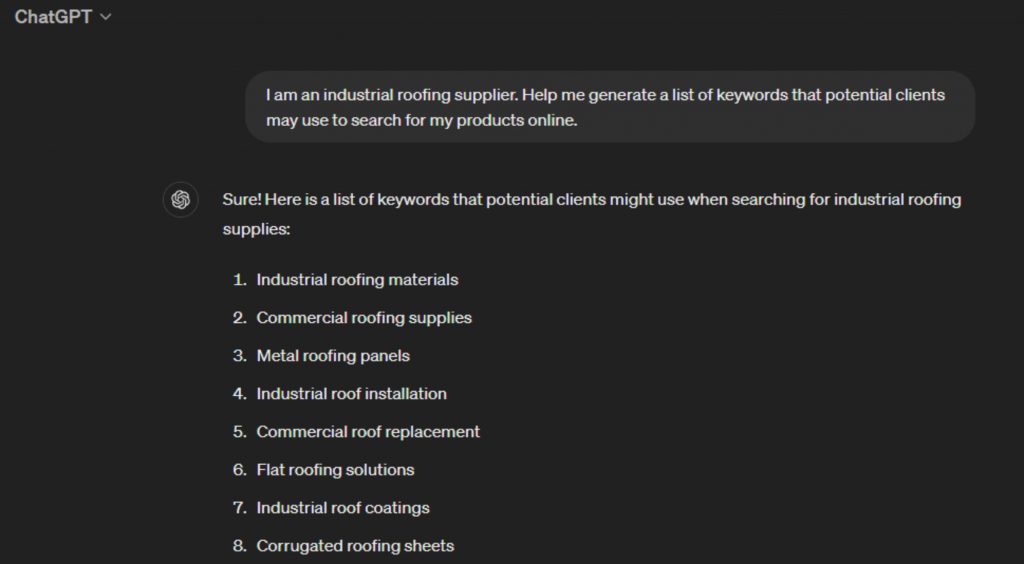
Additionally, you can find more keyword suggestions on search engine results pages (SERPs). This can help you find longer phrases (long-tail keywords) that your prospects use.
Analyze the “people also ask” and “related searches” sections. The autocomplete feature in the search bar can also be helpful. See the example below:
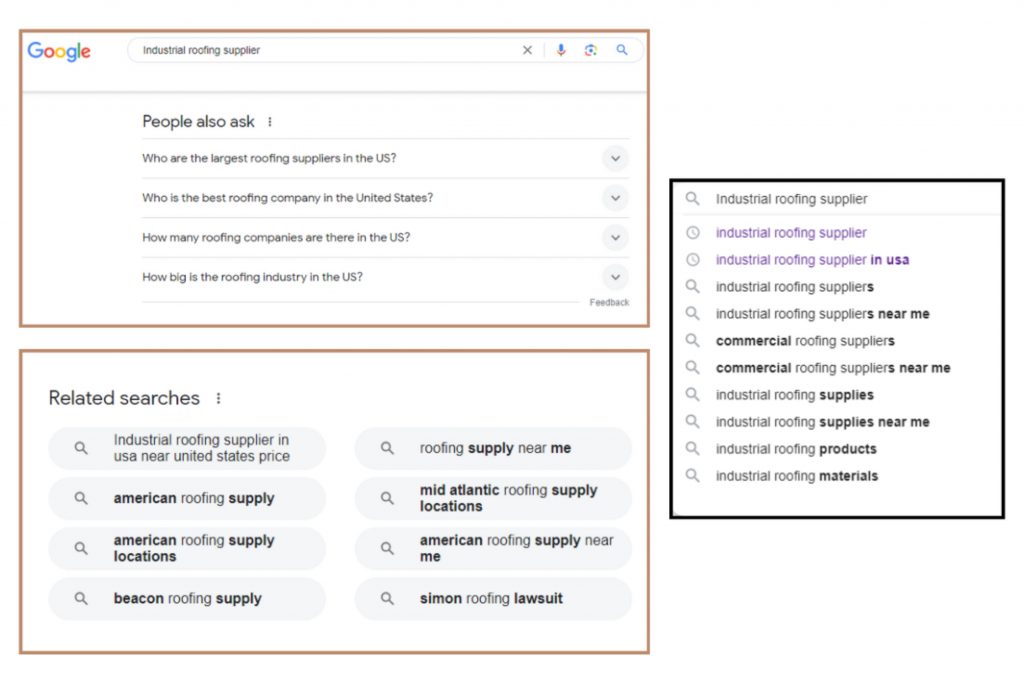
With a list of common keywords, you can start to narrow down your research.
Use Keyword Research Tools
Popular keyword research tools like Google Ads Keyword Planner can help you run detailed keyword research. These tools also let you see the search volume, competition, and related keyword suggestions. Check out the example below:
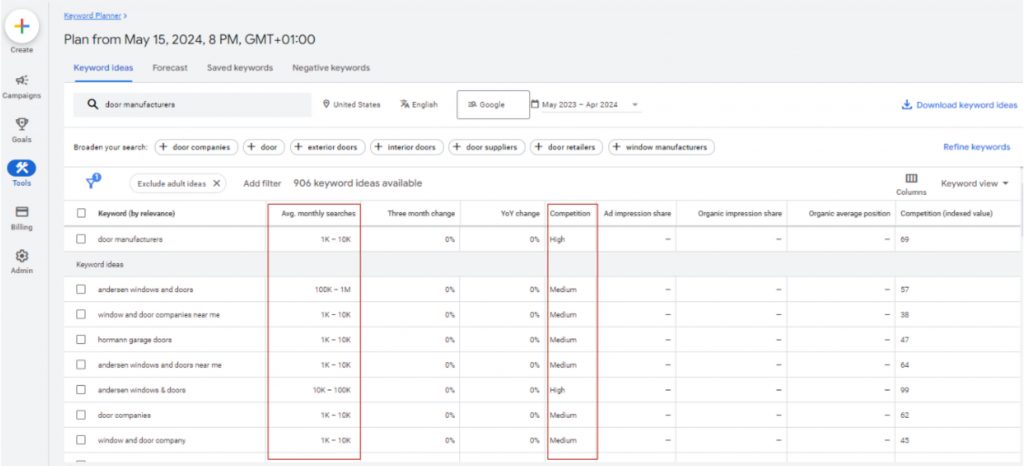
Paid tools like Semrush, Moz, and Ahrefs provide deeper insights into competition levels and keyword difficulty. You can also use these tools to reverse engineer your competitors’ content and keyword strategy.
Now, high-volume, generic keywords may seem appealing, but they’re fiercely competitive. Also, these keywords may not always translate to qualified leads.
Therefore, start your campaign by targeting keywords with medium-to-low competition and reasonable search volume. Less competitive long-tail keywords can also help you reach industrial clients who are more likely to convert.
Consider Search Intent
The key to effective keyword research lies in understanding the search intent behind each keyword. Search intent refers to the user’s goal when they enter a specific query. Typically, 99% of search terms fall within four categories of user intent:
- Informational: Users are seeking information, so they may use a search query like “how to improve warehouse efficiency” or “how to install outdoor lighting.”
- Commercial: The search intent is commercial when users start comparing product options. So they could have queries like “best clothing manufacturer.”
- Navigational: Users with this intent have a clear destination in mind. So they often search for specific brands or websites with queries like “Lform contact page” or “Lform web design.”
- Transactional: Users are ready to buy. For example, “where to buy office lighting in Detroit.”
Understanding the search intent behind each keyword helps you create content that aligns with users’ needs. In addition, it increases your chances of ranking higher on SERPs.
3. Produce High-Quality Content
Generally speaking, your website content will fall into two categories:
- Pillar content refers to comprehensive, in-depth pieces that tackle broad topics relevant to your industry and niche. They serve as a central hub that attracts visitors and emphasizes your expertise on a particular topic.
- Supporting content is often shorter and more specific. It explores specific subtopics in greater detail and links to the pillar page. This allows you to create a strong internal linking structure for your on-page SEO.
For example, if you’re a manufacturer of industrial valves, your pillar content topic could be “Industrial valve selection guide.” This piece would then cover various aspects of valve selection, such as types of valves, material considerations, pressure ratings, and application-specific factors.
Then, you’ll also have different articles that address each subheading as the main topic, for instance, one about “five major types of valves,” which links to the “Industrial valve selection guide.”
Besides creating helpful content that meets the intent behind each keyword, you’ll also need to optimize your content for search. This involves adding keywords to strategic places within your content and website.
For example, you’ll need to add keywords within the content body. You can use tools like Surfer and Frase to help with this process. Add keywords to the transcripts and video descriptions if you’re working with videos.
Relevant keywords should also be present in the page titles, meta descriptions, and image alt texts. Doing this can help your images show up when leads use relevant terms on search engines.
4. Optimize Your Website
In addition to optimizing the content you’re producing, you must also optimize your industrial website structure for SEO. This is sometimes referred to as onsite or on-page SEO.
You can start this process by using internal links to connect content and pages across your website. This helps search engines understand your site’s existing structure. It also shows the relationship between the different pages on your site and improves navigation and the user experience.
For instance, your home page should link to other major pages on your website. See how each section on Hockmeyer’s home page links to other subpages like the service page, product pages, and about page.

Additionally, ensure your site has a neat main menu that links to primary landing pages—products, services, about, etc. Your site’s footer can provide links to additional resources, glossaries, and other relevant sections.
Apart from basic on-page SEO, boost your technical website SEO by doing the following:
- Improve page load speed by optimizing images, code, and plugins. Slow sites lead to poor user experience and increased bounce rate, which is bad for SEO.
- Use HTTPS (Hypertext Transfer Protocol Secure) to ensure communication between your site and visitors is secure. A secure site can help search bots, and humans know you’re trustworthy.
- Create an XML sitemap that lists all the important pages on your site. Submitting your sitemap to search engines (via Google Search Console) helps search engine spiders crawl and index your content effectively.
Finally, optimize for responsiveness to ensure your web page renders well across different devices, including mobile devices.
5. Build High-Quality Backlinks
Backlinks are links from external websites to your own. That’s why they’re also called “inbound” links.
Typically, quality backlinks act as authority signals to search engine bots. This means that the more high-quality backlinks you get, the more believable it is that you’re offering helpful and valuable content. Websites with a strong backlink profile have the potential to rank higher in SERPs.
But what qualifies as a “high-quality backlink”? Generally, most SEO will use the following factors to vet the quality of a backlink.
-
- Website traffic: Websites with high organic traffic typically indicate valuable content and a strong reputation. So, aim to get backlinks from them.
- Spam score: Some websites are flagged as spam by search engines. These sites often have poor-quality content or excessive ads. They’re also mostly insecure. Links from sites with a medium-to-high spam score—say 31-100%, should be avoided.
- Domain authority (DA): DA measures how well a site ranks in search results. Avoid low-domain sites. Advisably, target sites with a DA score of 60-100. You can use the free Ahrefs domain authority checker tool to check the DA of the sites you’re targeting for link building.
That said, here’s how to build a strong backlink profile:
- Develop high-quality informative content that establishes your expertise. This could be case studies, research, or useful statistics that other sites would want to reference.
- Contribute guest blog posts to relevant industry publications or websites that align with your target audience.
Finally, repurpose your content and use it to create buzz on your social media channels. In addition to reaching a wider audience, social media can help other site owners discover and link your content.
6. Implement Local SEO Strategies
Local SEO strategies are important because they help you target a specific area. It’s pretty important for industries serving a specific locality.
Optimize your site so it’s easy for customers within your service location(s) to find you. For instance, see this Google search result for “shoe manufacturer in Denver”:
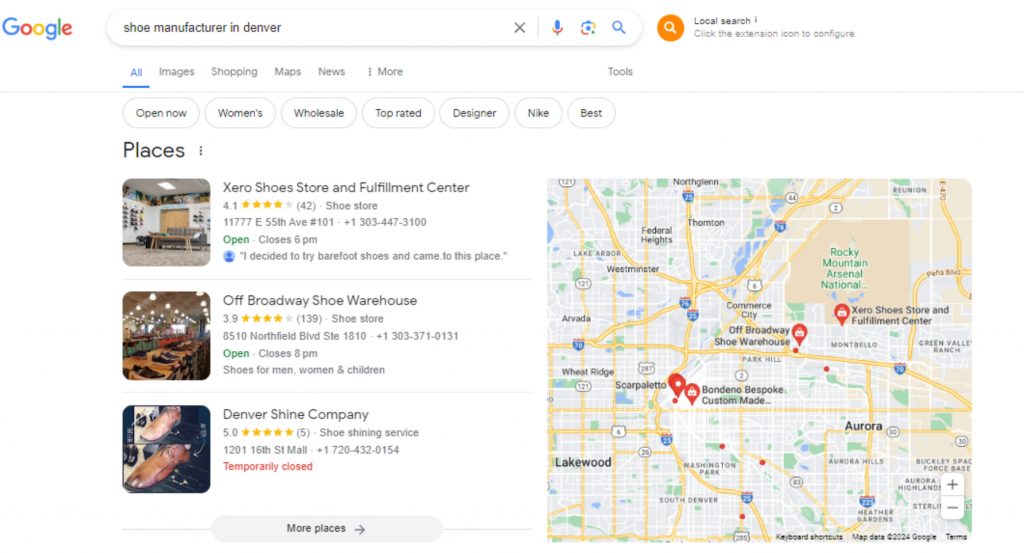
Here are some key ways to implement an effective local SEO strategy for your industrial website:
Create and Verify Your Google Business Profile
A Google Business Profile allows you to manage your digital presence across Google Search and Maps. To create your profile, go to this Google Business Profile page and input your business name. Then select “Add your business to Google.”
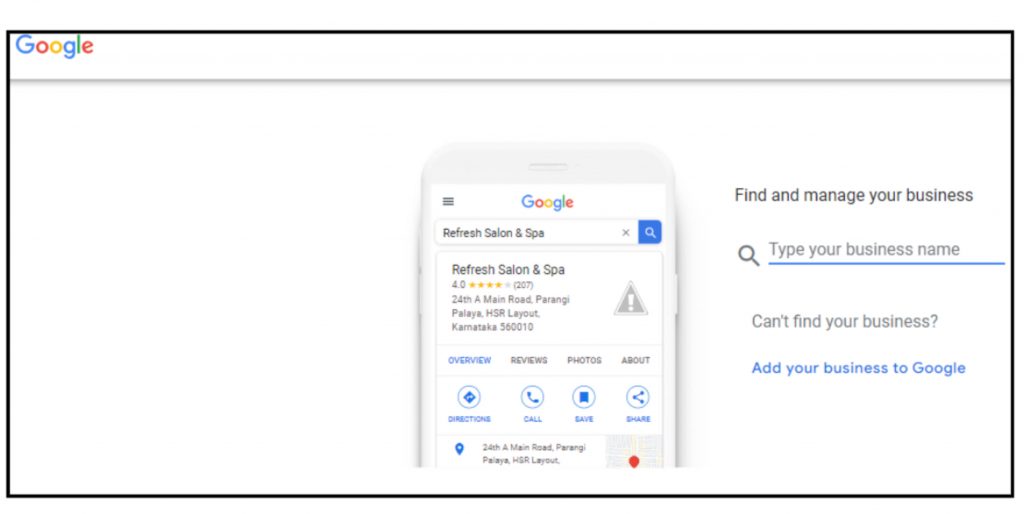
On the next page, fill out the form with accurate and complete details about your industrial company. Input your business name, address, website URL, business category, and phone number.
After you submit the information, Google will prompt you to verify your business ownership. Go ahead with that. You can verify your profile through a postcard, phone call, or video. Once that’s done, you can manage your profile.
Be sure to optimize your listing with a well-detailed description that contains relevant keywords. Also, encourage customer reviews so that you can build credibility and earn trust from potential clients.
In some cases, you may find a list of suggestions with your business name. These could be profiles created in the past, especially if you’ve been in business for a while. If you’re notified that someone else has verified your business, you can simply request ownership and follow the next prompts to claim your profile.
Include Your Location Across Your Site
This is commonly done on the site’s footer so that it reflects on every page. See the example below on L&R Ultrasonics’ website:
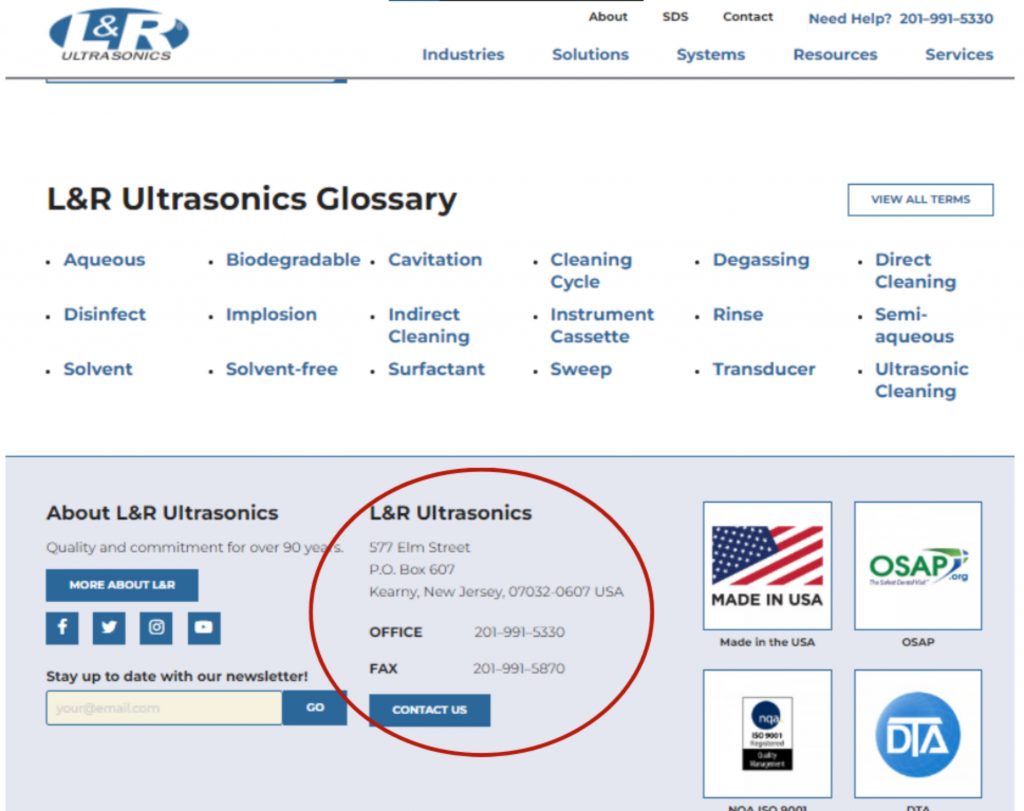
Also, create a dedicated contact page with your complete location details. Consider adding a map that shows your location, too, just like what we have on the Lform contact page:
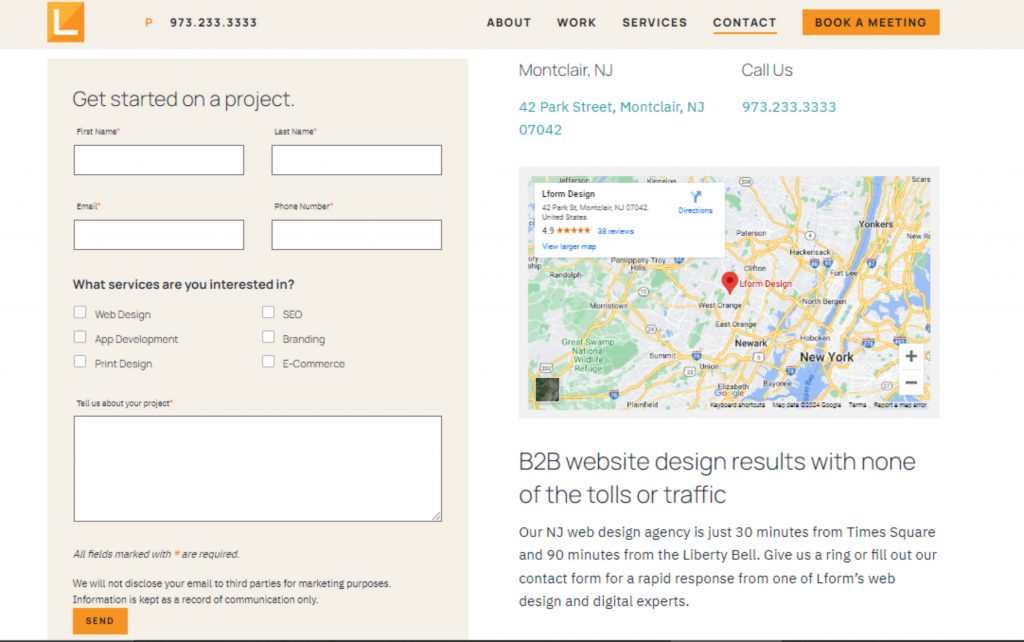
If you offer services in different areas, create location-specific service pages or simply list the various locations on your contact page.
Indicating your location across your site is quite helpful, as search engine crawlers can easily find and deliver your content to searchers in your area.
Take Advantage of Local Directories
Lastly, list your site on local directories. Consider industry-specific platforms and online Yellow Pages as well. Ensure your business name, address, and phone number (NAP) are consistent in all your online listings.
7. Monitor, Analyze, and Adjust
Regularly evaluating your SEO strategy helps you assess overall performance, identify loopholes, and make the needed improvements.
Considering that the goal of your SEO efforts is to boost online growth, here are some of the metrics to observe:
- Organic traffic: This is the amount of traffic your site receives from search engines without running ads. An increase in organic traffic signals that your SEO efforts are productive. And if more of that traffic converts into leads, it means your content is reaching the right people. You can use Google Analytics or Google Search Console to check this.
- Keyword ranking: Monitor your ranking for specific keywords. Tools like Google Search Console or Semrush can help you track your keyword positions over time.
- Backlink profile: Check the quality and quantity of inbound links to your site. More quality backlinks, especially from sites you didn’t pitch, indicate that you’re getting seen by the right people. Tools like Ahrefs, Semrush, or Moz come with a backlink checker that allows you to track your backlink profile and identify new backlinks.
You may also want to monitor other metrics, such as bounce rate, click-through rate, and pages per session. These will help you identify any site issues or improvement opportunities.
In Closing
No doubt, manufacturing companies need a strong and visible online presence to attract prospects. Also, potential customers are constantly looking for information online—they often seek answers to common questions or solutions to specific problems. As an industrial company, you can take advantage of this through a strategic SEO campaign.
This post reveals key steps to help you win with your industrial SEO efforts. First, you must cover the basics by understanding your target audience and industry. Next, lay the foundation through comprehensive keyword research.
Then, optimize your website, build high-quality backlinks, and implement local SEO strategies. Finally, monitor, analyze, and adjust your SEO strategy continuously.
Now, it’s your turn. Follow these tips and watch your industrial website grow online.



